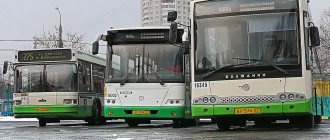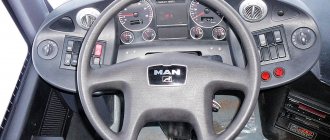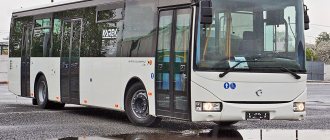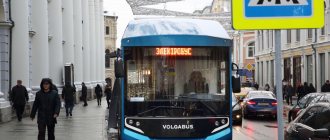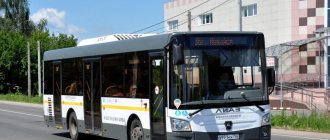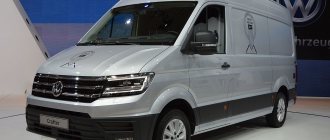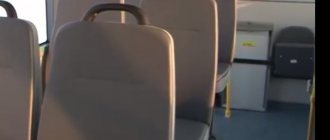Bus Volzhanin 52851. Photo Autoimport ST
There are not many bus manufacturing enterprises represented on the Russian market. The industry leader is the GAZ Group, which includes several plants: Pavlovsky, Likinsky, Kurgansky, and until recently Golitsynsky. The list of factories that have ceased to exist includes the famous ZIL. ]Volzhanin[/anchor]" no longer produces vehicles under its own brand, but the company continues to operate. This article is devoted to the history of the enterprise and popular models of Volzhanin buses.
About the manufacturer
The plant was founded in 1993. In the first few years, the company specialized in assembling buses from kits from the Likinsky Bus Plant. In 1995, production of tourist-class equipment began, and a model for intercity travel, 5268, . From 1995 to 1997, work was carried out on the creation and assembly of prototypes of Volzhanin-5270. In 1998, production was certified according to the international quality system ISO 9001, and a certificate was received for the development and production of TUV CERT buses.
In 1999, serial production of buses under the Volzhanin brand began. In 2000, serial production of suburban and intercity models began. In 2003, a 15-meter intercity airliner on a Scania chassis was created (!for the first time in Russia). In 2004, a prototype of a small bus on a TATA chassis, Volzhanin-3290, was created. In 2006, the first completely low-floor bus in the Russian Federation with a body made of aluminum alloy, CityRhythm, was created.
Bus CityRhythm-15. Photo Wikipedia
In 2006, Volzhanin became the first Russian plant to present its bus at the world exhibition of commercial vehicles "IAA" in Hannover, Germany , and in 2007 - at the main world exhibition "Busworld" in the city of Kortrijk (Belgium). Despite the success of the enterprise and its products, in 2007 the production of buses under the Volzhanin brand ceased. At the same time, the company became part of the Volgabus holding.
Popular models
6270
Volzhanin-6270 is a 15-meter three-axle single-section city bus of an especially large class. One of the longest single-section models in the world. Designed to work on urban routes with large passenger traffic. The bus complies with Euro-3 environmental safety standards.
Description and device
Scope of application. Volzhanin-6270 is a high-capacity city bus. Due to the design features, the model could also be used for intercity transportation.
Main nodes.
Engine. The first models were equipped with a Scania DC903 power plant with a power of 300 hp. With. Subsequently, the engine was replaced by the German Deutz BF6M 1013FC. This is a six-cylinder unit with an in-line cylinder arrangement and turbocharged fuel supply. Engine power – 299 hp. s.B
Transmission. 6-speed automatic transmission ZF ECOMAT2 PLUS 6 HP 2C. Hydromechanical system with extended operating range and dual temperature control. Drum brake system.
Body. All-metal single-story car-type building. The frame is welded from high-strength alloy steel, the driver's cabin is closed. The body is presented in a three-door design, designed to comfortably accommodate 140 passengers, 32 seats, plus a conductor’s seat. The manufacturer guaranteed protection against corrosion for 10 years.
Years of manufacture
Initially, since 2001, the bus was produced only in a high-floor version, but since 2005, production of a semi-low-floor modification began, which is almost half a meter shorter. The bus was produced until the beginning of 2008, in fact, to replace this bus, the production of a more modern Volzhanin CityRhythm-15 of the same class, built on a factory chassis, began.
Basic characteristics
- Body dimensions, mm. (LxWxH). 15220x2500x3150.
- Body warranty against through corrosion, years. 10.
- Number and type of doors. Three double-leaf swing doors.
- Total number of seats, including landing seats. 140, including 32 landings.
- Type of seats. Separate semi-soft with handrails.
- Electrical equipment. 24 V, single-wire network.
- Glazing. Pasted tinted.
- Driver's cabin. Closed type.
Specifications
- Fuel type. Diesel.
- Fuel tank capacity, l. 465.
- Curb and technically permissible weight, kg. 15280 and 25000.
- Load on front/middle/rear axle based on technical permissible weight, kg. 7000/11500/6500.
- Minimum turning radius, m. 12.
- Front approach angle/rear departure angle, degrees. 7/7.
- Steering gear. ZF 8098.
- Resource, km. Not less than 1,000,000.
- Brake system. Pneumatic WABCO with ABC/PBS; All wheel brakes are drum brakes.
Chassis characteristics
- Main bridge. Scania, ADA 1300.
- Drive wheels. Medium, with dual-pitch tires.
- Wheel formula. 6x2.
- Wheelbase, mm. 6950+1500.
- Tires. 275/70 R22.5.
- Anti-lock braking system (ABS). Present.
additional characteristics
- Ventilation. Natural.
- Heating system. Present.
Engine/powertrain characteristics
- Model. Scania DC 9 03.
- Type. Diesel.
- Number and arrangement of cylinders 6 6, in-line.
- Environmental safety standards. Euro-3.
- Working volume, l. 8,97.
- Engine power, kW (hp)/min. 221 (300).
- Maximum torque, Nm/min. 1400 at 1100–1300 rpm.
- Engine location. Rear longitudinal.
- Resource, km. 1 000 000.
- Checkpoint. ZF ECOMAT2 PLUS 6 HP 502 C (Germany).
- Design. Automatic 6-speed hydromechanical with an extended range of hydraulic retarder operation, a modern control system, dual temperature control and a smooth reduction in braking torque.
- Resource, km. Not less than 1,000,000.
- Suspension. Pneumatic dependent.
- Control fuel consumption at 60 km/h, l/100 km. 32.
- Maximum speed, km/h. 120.
Advantages
- The capacity is almost as good as that of popular articulated models. At the same time, the equipment takes up less space on roads and stops.
- The absence of an articulated trailer greatly simplifies driving, so category “D” is sufficient for such models.
- Refusal of articulated elements implies a simplified circuit of electrical equipment, braking and control systems. Taken together, this helps to significantly reduce production costs.
- The use of more practical and compact equipment has helped to increase the number of cars on routes.
Video
Cityrhythm 12, 15, 18: 2022 and more
Volzhanin "CityRhythm" is a family of Russian low-floor city buses, produced since 2005, developed on the basis of Volzhanin-5270 and Volzhanin-6270. In 2012, the line was restyled.
Volzhanin CityRhythm (until 2012)
Volzhanin-5270-20-06 "CityRhythm-12".
In 2005, the Volzhanin holding prepared an experimental 12-meter model, CityRhythm-12, completely low-floor. Compared to the Volzhanin-5270 model, the interior layout was also changed. The Scania chassis was no longer used, as on the Volzhanin-6270. I installed the steering wheel along with the dashboard.
Volzhanin-5270-20-06 "CityRhythm-12". Photo Wikipedia
In 2006, the second copy of this model was released, already with an aluminum body, but mass production began in 2007. Production of the model ceased in 2012 due to the restyling of the line.
The buses are designed to carry 104 passengers, with 28 seats, four of which (in the storage area) are folding ones.
The bus was equipped with a six-cylinder Deutz BF6M1013FC engine with a power of 285 hp. meeting the Euro-3 environmental standard and an automatic six-speed gearbox ZF Ecomat 6HP502 C. Drive axle ZF AV-132/90.
Main characteristics
- Body dimensions, mm. (LxWxH). 11945x2550x3150.
- Number and type of doors. Three double-leaf swing doors.
- Total number of seats, including landing seats. 105, including 21 landings.
- Type of seats. Separate plastic with soft inserts and handrails.
- Fuel type. Diesel.
- Curb and technically permissible weight, kg. 11000 and 18500.
- Front/rear overhang, mm. 2885/3400.
- Front/middle/rear wheel track, mm. 2080/1836/2080.
- Wheel formula. 4x2.
Volzhanin-6270.06 "CityRhythm-15"
Due to the market demand for especially large class buses, as well as the high price of the Scania chassis, on the basis of which a similar Volzhanin-6270.10 model was produced, in 2007 the Volzhanin holding released the three-axle Volzhanin CityRhythm-15. After testing two copies of this model in the 14th bus depot, mass production of the model began at the end of 2007. In fact, the bus began to be produced to replace the bus on the Scania Volzhanin-6270.10 chassis, which was discontinued almost simultaneously. The first representative of this model was transferred to Mosgortrans, to the 1st bus depot.
Bus Volzhanin-6270.06 "CityRhythm-15". Photo Wikipedia
All Moscow "CityRhythms-15" delivered before 2010, with the exception of 01376, have interiors assembled at TMZ (like almost all buses of extra large capacity 2005-2009), which is why they differ from other seats and the color of the handrails. In 2010, a batch of CityRhythms-15 came to Moscow with a factory interior similar to the Moscow SR-12. Similar to the Volzhanin CityRhythm-12, the bus was equipped with a six-cylinder Deutz BF6M1013FC engine with a power of 285 hp. meeting the Euro-3 environmental standard and an automatic six-speed gearbox ZF Ecomat 6HP502C. Drive axle ZF AV-132/90. Gearbox – WABCO or KNORR-BREMSE (Germany), electro-pneumatic with an electronic air suspension control system (ECAS), which provides the function of kneeling and floor lifting.
Unlike Volzhanin CityRhythm-12, the bus does not have steps at all doors, while on CityRhythm-12 there is a low step in the rear doorway. However, CityRhythm-15 has a raised floor in the area of the drive axle. In addition, CityRhythm-15 is equipped with tires of a higher size than CityRhythm-12.
In 2012, production of the model was discontinued.
Basic characteristics
- Body type. Carriage layout, one-story, closed, load-bearing; with a load-bearing, all-metal, welded base; frame front and rear, made of low-alloy steel profiled pipes of rectangular section; The sides and roof are framed, from a system of rectangular aluminum profiles developed by ALCAN. The vertical pillars of the sidewalls are continuous and interlocking bases and roofs, forming a rigid unit. Noise and thermal insulation of the body. The glazing is glued in and tinted.
- Body dimensions, mm. (LxWxH). 14660x2550x2970.
- Number and dimensions of doors. Three double-leaf swing doors.
- Total number of seats, including landing seats. 140, including landing 33+4+1.
- Type of seats. Separate plastic with soft inserts and handrails.
- Electrical equipment. 24 V, single-wire network.
Specifications
- Fuel type. Diesel.
- Fuel tank capacity, l. 380.
- Curb and technically permissible weight, kg. 14500 and 24500.
- Steering gear. ZF 8098.
- Brake system. Pneumatic double-circuit.
Chassis characteristics
- Wheel formula. 6x2.
- Wheelbase, mm. 6950+1550.
- Tires. 275/70 R22.5.
- Anti-lock braking system (ABS). Present.
Volzhanin-6271 "CityRhythm-18"
The first articulated model of the VAP "Volzhanin". Released in a single copy.
Bus Volzhanin-6271 "CityRhythm-18". Photo Wikipedia
Taking into account the needs of transport workers for a more maneuverable vehicle with high passenger capacity, in 2010 Volzhanin released the articulated 18-meter CityRhythm-18. The German concern MAN acted as a technological partner for the project, which supplied the MAN A24 NG313F chassis. Wide storage areas combined with a thoughtful layout made it possible to increase the total passenger capacity to a record for its class of 178 people. The car has 4 wide doorways, making it easier for passengers to enter and exit, as well as a body tilting system (kneeling), which adapts the height to the landing area.
The presentation of the car took place from September 7 to September 9, 2010 at the Expositytrans exhibition at the Crocus Expo International Exhibition Center (pavilion 2). Here an agreement was signed to transfer the bus for control tests to the State Unitary Enterprise Mosgortrans.
In 2011, this vehicle was tested in the 11th Moscow bus depot, receiving board number 11144, on routes 851 and 194, a little later, one year it worked on bus route No. 139 (Metro Filevsky Park - Trekhgorka Platform) during route maintenance by IP Ukhanov.
Basic characteristics
- Body dimensions, mm. (LxWxH). 17945x2550x3150.
- Number and type of doors. Four double-leaf swing doors.
- Total number of seats, including landing seats. 147, including 32 landing ones.
- Type of seats. Separate plastic with soft inserts and handrails.
Specifications
- Fuel type. Diesel.
- Curb and technically permissible weight, kg. 16500 and 28000.
- Load on front/middle/rear axle based on technically permissible weight, kg. 6300/10300/11400.
- Minimum turning radius, m. 12.
- Front approach angle/rear departure angle, degrees. 7/7.
- Brake system. Three-circuit, electronic-pneumatic. ABS. ASR. EBS.
Chassis characteristics
- Wheel formula. 6x2.
- Wheelbase, mm. 5105+6770.
- Front/middle/rear wheel track, mm.
2076/1826/2076. - Front/rear overhang, mm.
2700/3405. - Anti-lock braking system (ABS). Present.
Engine/powertrain characteristics
- Model. MAN D2066 LUH22.
- Type. Diesel.
- Number and arrangement of cylinders. 6, in-line.
- Environmental safety standards. Euro-4.
- Working volume, l. 10,518.
- Engine power, kW (hp)/min. 228 (310)
- Maximum torque, Nm/min. 1550 at 1000–1400 rpm.
- Checkpoint. automatic six-speed ZF Ecomat 4 6HP604C.
- Front-rear axle suspension. Pneumatic, dependent-Pneumatic, dependent.
- Maximum speed, km/h. 90.
Volgabus CityRhythm (since 2012)
After the Volzhanin plant became part of the Volgabus holding, the models continued to be produced, but under a different brand.
Volgabus-5270 "CityRhythm-12". In 2012, a new modification Volzhanin-5270-20-06 with a new design of body masks and a shaft engine arrangement was launched into production. In order to reduce the cost of the bus, the aluminum body cladding was replaced with steel.
- Volgabus-5270.02.
- Volgabus-5270.G0. In 2014, a new modification was launched into production. Produced in 2014 and 2022. 82 buses were produced.
- Volgabus-5270.G2. In 2015, a new modification was launched into production. Produced since 2015.
- Volgabus-5270.05. Released in 2013. 70 pieces produced.
- Volgabus-5270.07. B was released in 2012-2013. 2 copies were released.
- Volgabus-5270.0Н. There are suburban and urban versions (they differ in the interior layout and the middle door). It differs from 5270.00 in length (10 versus 12 meters - shortened) and the absence of a rear door.
- Volgabus-5270.GН. Produced since 2017.
- Volgabus CityRhythm-12E. Electric bus, produced from 2022.
Volgabus-6271 "CityRhythm-18". An updated version of Volzhanin-6271 “CityRhythm-18” with a new design of body masks and a shaft engine arrangement. Produced since 2012.
Volgabus-6271.05. Version with a more powerful engine.
Video
5285, Scania 52851 "Dolphin"
Volzhanin-5285 is a 46-seater intercity bus on a Scania chassis. The body is carriage type, closed and all-metal. The frame is assembled from low-alloy steel with increased corrosion resistance with facing panels made of galvanized steel. The power unit is located in the rear overhang, longitudinally. The driver's cabin is semi-closed. Layout - with a rear longitudinal engine; double-glazed windows - glued. Optionally, a dry closet, BLAUPUNKT audio-video system and a kitchen unit can be installed.
Characteristics
- Overall dimensions, mm. 12015x2550x3245.
- Engine model. RABA D 10 TLL-206.
- Maximum speed, km/h. 120.
- Technically permissible weight, kg. 18500.
- Wheel formula. 4x2.
- Front/rear wheel track, mm. 1840x2050.
- Fuel tank volume, l. 380.
- Number and type of doors. Two single-leaf sliding doors.
A modification of model 5285, Volzhanin-52851, has gained great popularity.
Another modification is Volzhanin-52581 Dolphin, this is a luxury class option.
Dolphin is a comfortable tourist bus , intended for work on regular long-distance routes, tourist trips, corporate and departmental transportation. The bus featured progressive biodesign and the latest design solutions: a body made of lightweight, corrosion-resistant aluminum alloy, external skin, floor and roof made of composite materials. The bus was equipped with modern active and passive safety elements and was equipped with an EBS braking system. The interior is decorated with safety, fire-resistant materials.
Characteristics
- Overall dimensions, mm. 12430x3750x2550.
- Number and type of doors. Three single-leaf sliding doors.
- Capacity, including number of seats. 52 or 45+2.
- Luggage compartment volume, cubic meters 10.
- Brake system. Pneumatic braking system. Disc brakes. Completely independent circuits on the front and drive axles, parking and compression brakes. Electronic control, ABS, PBS
- Chassis. Sсania K380EB4X2.
- Turning radius, m. 11,276.
- Engine. Scania, Euro 5. 5-cylinder, diesel. 4 valves per cylinder, HPI injection system, turbocharging, intercooling, EMS control system Displacement - 11,700 cc. see Max. power - 279 kW (380 hp) at 1800 rpm. Max. torque 1900 Nm at 1100-1400 rpm.
- Transmission. Scania GR875R. Mechanical, 8 speeds. Retarder with manual and automatic control.
- Suspension. Pneumatic. Stabilizers on all axes. Electronic suspension control system with the function of raising and lowering the chassis.
- Steering gear. With hydraulic booster "ZF"
- Tires. 295/80R22.5.
This model was also produced under the Volgabus brand:
- Volgabus-5285.00. Produced in 2012-2018. 48 buses were produced.
- Volgabus-5285.02.2018-2019. thirty.
- Volgabus-5285.05. 2017-2018. 22.
- Volgabus-5285.12. 2016. 5.
- Volgabus-5285.D0. 2016. 23.
- Volgabus-5285.D2. 2022. 10.
- Volgabus-5285.G2. In 2015, a new modification was launched into production. 104 buses were produced.
Video
5270: 45 seats and more
Volzhanin-5270 is a family of Russian buses produced since 1997. The list of modifications includes buses for city, suburban and intercity travel. They differ not only in purpose, but also in capacity/number of seats, model and engine characteristics. One of the models - intercity Volzhanin 52702 - can accommodate 45 passengers.
City bus Volzhanin-5270. Photo Autoimport ST
Volzhanin-52702 is a bus for use on medium and long-distance intercity routes , as well as as a sightseeing bus. It combines a spacious, comfortable interior, optimal operating costs and ease of maintenance. This model, at the request of the customer, can be equipped with the BLAUPUNKT audio-video system and the THERMO KING climate control system. The frame is made of low-alloy high-strength ship steel 09G2S with increased corrosion resistance and facing panels made of galvanized steel. The capacity of the luggage compartments is 4.5 cubic meters. The layout is with a rear longitudinal engine; glass - glued. Body type - carriage, single-story, load-bearing, closed, all-metal. Other information about the model and its modifications is presented in a separate review.
3290 on TATA chassis, 32901: 2004 year of manufacture, technical specifications and so on
Volzhanin 3290 is a small class bus based on the Indian TATA LP-613/38 BUS chassis. Initially, the model was tested on various chassis, but ultimately preference was given to TATA Motors. The model entered production after many years of testing in 2004. This chassis is also actively used on Ukrainian Etalon vehicles. The bus had two passenger doors sliding outwards or one double swing door and a driver's door on the left.
"Volzhanin-3290" is equipped with 21 seats for passengers (total capacity 35 people) and a luggage compartment of 1.5 cubic meters. The car body is closed, all-metal, welded with a frame made of low-alloy high-strength steel of rectangular section with galvanized seamless glued sides. Small dimensions, an optimal number of seats and a diesel engine make the Volzhanin-3290 economically viable for various types of transportation.
In 2007, an updated version was released based on the same TATA LP 613 chassis. The bus was presented to the public at the international exhibition Interauto-2007.
Basic characteristics
- Body type. Carriage, single-story, closed, all-metal, welded with a frame made of low-alloy high-strength steel of rectangular section with galvanized seamless glued sides. The roof cladding is made of seamless sheets with no transverse joining seams. Noise and thermal insulation of the body. The glazing is glued in and tinted.
- Driver's cabin. Semi-closed type, access to the driver’s workplace is through the driver’s door and the passenger compartment.
- Layout diagram. Carriage; engine location – front.
- Body dimensions, mm. (LxWxH). 8000x2200x2870.
- Number and dimensions of doors. Two single doors in the base and rear overhang.
- Total number of seats, including landing seats. 40, including 24+1 boarding.
- Type of seats. Separate soft with a high back.
- Body warranty against through corrosion, years. 10.
Specifications
- Fuel type. Diesel.
- Curb and technically permissible weight, kg. 5020 and 7500.
- Steering gear. ZF with hydraulic booster.
- Brake system. Pneumatic double-circuit drive with division into circuits along the axes, with ABS (“KNORR-BREMSE”); All wheel brakes are drum brakes.
Chassis characteristics
- Brand. TATA.
- Drive wheels. Rear.
- Wheel formula. 4x2.
- Anti-lock braking system (ABS). Present.
Engine/powertrain characteristics
- Model. TATA 697 TC 55.
- Type. Diesel four-stroke.
- Number and arrangement of cylinders. 6, in-line.
- Environmental safety standards. Euro-3.
- Working volume, l. 5,675.
- Engine power, kW (hp)/min. 96 (130).
- Checkpoint. TATA G-40; 5-speed manual, synchronized in all gears.
- Suspension. Pneumatic bridge TATA 379032, dependent, spring.
- Control fuel consumption at 60 km/h, l/100 km. 16-19.
- Maximum speed, km/h.
6216
The 15-meter Volzhanin-6216, built on a complete Scania chassis, is a further development of the Volzhanin-5285 model, in contrast to which it is already equipped with a toilet and a utility compartment as standard. Just over 20 units of the model were produced, so there is little information about it.
Characteristics
- Engine model. Scania DSC1104.
- Maximum torque at speed. 1900 at 1100
- Overall dimensions, mm. 14700x3700x2550.
- Wheelbase, mm. 7230+1500.
- Wheel formula. 6x2.
- Number of seats. 60.
- Gearbox type. Mechanical, 7/1.
- Volume of luggage compartments, cubic meters 14.
- Number and type of doors. The first is single-leaf, the second is double-leaf.
4298 Rhythmix
Suburban bus of medium class capacity.
Characteristics
- Overall dimensions, mm. 8200x2330x2765.
- Total number of seats, including landing seats. 56.
- Curb weight, kg. 4600.
- Wheelbase, mm. 4200.
- Wheel formula. 4×2.
- Tires. 235/75R17.5.
- Engine model. H6E4S123.
- Type. Diesel.
- Environmental safety standards. Euro-4.
- Working volume, l. 5,759.
- Power. 123 (167) 2500 rpm.
- Number and arrangement of cylinders. 6, in-line.
- Maximum speed, km/h. 116.
- Checkpoint. Mechanical five-speed.
- Fuel tank volume, l. 115.
This model was also produced under the Volgabus brand:
- Volgabus-4298. Produced in 2011-2012. 3 copies were released.
- Volgabus-4298.00. 2012-2014. 25.
- Volgabus-4298.01. 2012-2014. 204.
- Volgabus-4298.01-01. 2012-2013. 9.
- Volgabus-4298.G7. 2013-2014. 18.
- Volgabus-4298.G8. 2013-2015. 87.
38 seats
Internet users are interested in models with 38 seats. However, there are no models in the manufacturer’s model line that meet this request.
What's the result?
Electric buses are not cheap, and without government help, fleets would not be able to afford such a purchase. Today the market value of the electric bus is 30 million rubles. The state subsidizes the purchase in the amount of 8 million rubles, the rest comes from Passazhiravtotrans’ own funds.
At the same time, taking into account the positive experience in operating electric buses, it is planned to purchase about 40 more such vehicles. However, this will only become possible after the introduction of a new substation, which will ensure full charging of electric buses.
The management of Passazhiravtotrans believes that electric buses are the future in providing passenger transportation for a metropolis such as St. Petersburg. In addition, this is an environmentally friendly vehicle, which is almost completely free of harmful emissions, because the city is growing at a rapid pace and environmental problems will only get worse.
For reference
In 2016–2018, Passazhiravtotrans tested various modifications of electric buses with long-term and ultra-fast charging. After assessing the technical and economic indicators, the choice was made in favor of night charging, which ensures a long range of the electric bus. In 2022, following an auction, 10 Volgabus electric buses were purchased. Vehicle charging is carried out at night in the bus depot and does not require additional infrastructure. The installation of charging stations for ultra-fast charging at stopping points in St. Petersburg is fraught with coordination difficulties, including in terms of UNESCO requirements for the protection of architectural heritage.
